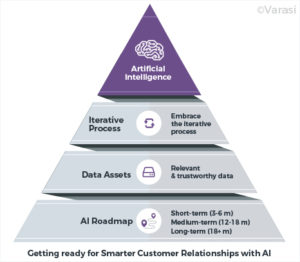Smart companies know artificial intelligence (AI) will soon become a pervasive part of our professional and personal lives. It has the potential to drive smarter customer relationships and be a competitive advantage. But how do business leaders get their companies ready for AI? To make AI your differentiator; there are three foundational aspects to put in place in order to realize meaningful results:
 Chart your AI roadmap
Chart your AI roadmap- Setup the required data assets
- Understand and commit to an iterative process
1. Chart your AI Roadmap
Think ahead and put short term (3-6 months), medium term (12-18 months) and long term (18+ months) goals for impact that you want to create using AI. Identify the highest impact areas in your business and prioritize them. To prioritize in this way you will need a very good understanding of the capabilities and limitations of AI.
It is best to chart this roadmap in a workshop setting involving multi-department stakeholders to establish common ground around AI capabilities and marry them with the business priorities, keeping in mind there are 3 factors that will determine the success of your AI initiative:
- Data = Relevant and trustworthy data
- Technology = Infrastructure and algorithms needed to mine the data
- People = AI specialists/Data Scientists and subject matter experts to configure and tune the algorithms
2. Setup the required data assets
If there is one thing that can make or break your AI initiative, it is the relevance and quality of your data. Without the right data you can employ the best algorithms and the best people on the planet and you will still not get meaningful results. (Garbage-in-garbage-out, right?) Setting up your data and data infrastructure is non-trivial. The more relevant data that you can make available, the better your AI algorithms will perform. Not all data will be in one place or even owned by you. Data will be inside your organization, with partners, data providers, government/public domain and so on. Making the data available to your team is not just a technology problem. There are a number of business, security and compliance-related issues around data that are equally important and can show up as roadblocks. Someone senior enough in the organization needs to own this critical piece to ensure that the entire initiative doesn’t break down.
The second part of the data puzzle is the technology. You need strong Big Data and distributed computing strategies in place. Most companies now do have this in some shape or form. But if you don’t, then its time to set it right because processing very large volumes of data using the old technology stack is just not economically and technically viable. One key aspect to consider in the design is the reality of a hybrid environment i.e. some data will always reside within your premises and some will be across various cloud systems that you have adopted.
3. Understand and commit to an iterative process
Remember, AI feeds on iterations. We are talking about a very dynamic world. Nothing is constant. Your business, customers, data, and customer behavior – everything is constantly changing. So there is no such thing as setting up an AI system and being done with it.
Understanding this crucial side of the process is important because we are used to setting up transactional and reporting systems that go through a requirement – development – production – support cycle. You may have agile methodologies to do this. But AI is different. You have to think of it as though you are always in development. That is what it takes to maintain your edge with AI.
Anil Nair is Managing Principal of Varasi. Click here to read the full text of this post on Varasi.com.
